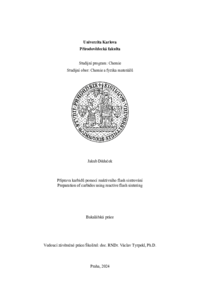Příprava karbidů pomocí reaktivního flash sintrování
Preparation of carbides using reactive flash sintering
bachelor thesis (DEFENDED)

View/
Permanent link
http://hdl.handle.net/20.500.11956/194256Identifiers
Study Information System: 263376
Collections
- Kvalifikační práce [20352]
Author
Advisor
Referee
Zákutná, Dominika
Faculty / Institute
Faculty of Science
Discipline
Chemistry and Physics of Materials
Department
Department of Inorganic Chemistry
Date of defense
10. 9. 2024
Publisher
Univerzita Karlova, Přírodovědecká fakultaLanguage
Czech
Grade
Excellent
Keywords (Czech)
karbid titanu, reaktivní flash sintrování, slinování za asistence elektrického pole, karbotermální redukce, vysokoteplotní keramikaKeywords (English)
titanium carbide, reactive flash sintering, field assisted sintering, carbothermal reduction, high temperature ceramicsCílem této práce bylo ověřit možnost přípravy TiC za pomoci moderní metody přípravy a zpracování keramických materiálů využívající elektrické pole. Jako výchozí látky byly použity připravený TiO2 a komerčně dostupný grafit. Směs byla ve formě vylisovaných tablet podrobena ohřevu v elektrickém oblouku při různých podmínkách. Pro samotné experimenty byly využity elektrody z měkkého grafitového filcu, které dobře eliminovaly křehkost výchozích tablet. Byly provedeny dvě sady experimentů, jednak v argonové atmosféře a dále v argonovém vakuu. Syntéza byla úspěšná pro molární poměr Ti:C ve výchozí směsi 1:3 a aplikované napětí 25 V, přičemž důležitá byla přítomnost vakua při reakci. Experimenty v argonové atmosféře při atmosférickém tlaku vykazovaly sporadickou konverzi na karbid, na rozdíl od experimentů ve vakuu, kde byla přeměna kvantitativní. Klíčová slova: karbid titanu, reaktivní flash sintrování, slinování za asistence elektrického pole, karbotermální redukce, vysokoteplotní keramika
The main aim of this thesis was to prove the possibility of TiC preparation using modern synthetic and processing technique assisted by electric field. The starting material consisted of prepared TiO2 and commercially available graphite. The mixture was pressed into tablets and treated in electric circuit under different conditions. Soft graphite felt electrodes were used for the experiments, these eliminated the low fracture toughness of the pressed pellets. Two sets of experiments were conducted, firstly in argon under atmospheric pressure, and later under argon vacuum. The synthesis was successful for molar ratio Ti:C 1:3 in the initial mixture and applied voltage 25 V, while the presence of vacuum was crucial. The experiments in argon gas under atmospheric pressure showed sporadic conversion to carbide, while the experiment under vacuum led to quantitative conversion. Keywords: titanium carbide, reactive flash sintering, field assisted sintering, carbothermal reduction, high temperature ceramics
